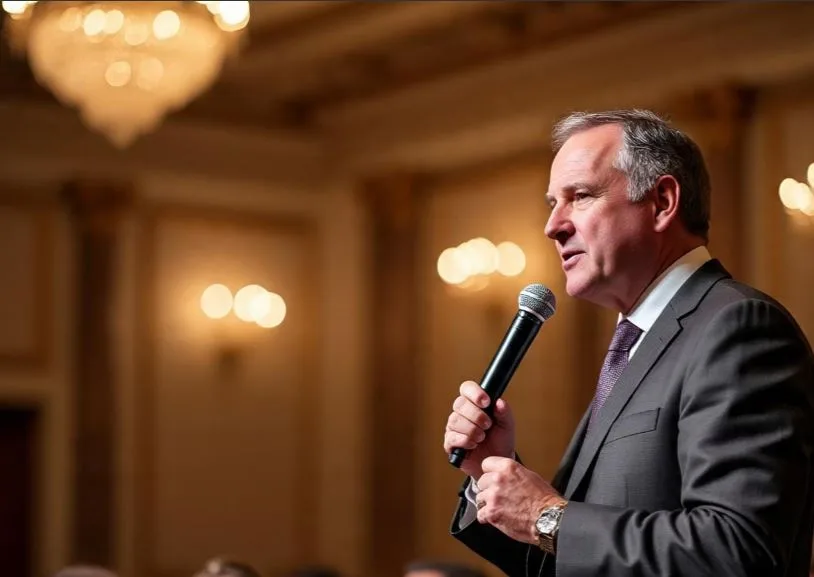How Conference Keynote Speakers Command the Room
A conference keynote speaker is more than a presenter delivering information. They are a guide, an influencer, and in many ways the heartbeat of the event. When done well, a keynote sets the tone for everything that follows. Attendees lean forward in their seats, eager to engage, and walk away with a sense of clarity, energy, and connection. But what makes a conference keynote speaker able to command the room? The ability to capture attention, maintain it, and leave a lasting impression comes from a combination of preparation, delivery, authenticity, and an understanding of audience psychology.
The Power of Presence
The moment a keynote speaker steps onto the stage, their presence communicates as much as their words. Attendees make instant judgments based on body language, confidence, and energy. A strong posture, steady eye contact, and purposeful movements project authority. Even before a word is spoken, the audience can feel whether they are in capable hands. Presence also involves energy management. A skilled conference keynote speaker knows how to balance enthusiasm with control. Too much energy without structure can overwhelm. Too little can bore. The right mix inspires confidence and keeps listeners engaged.
Storytelling as the Anchor
At the heart of every memorable keynote is storytelling. Facts and statistics have their place, but stories are what people remember. Humans are wired to connect through narrative. A conference keynote speaker who can transform abstract concepts into relatable, emotional stories builds immediate rapport. Stories create bridges between the speaker and the audience. They transform a keynote from being a lecture into a shared experience. The best speakers use a mix of personal anecdotes, customer stories, and broader narratives that highlight struggles, turning points, and victories. By doing this, they not only entertain but also inspire attendees to see themselves in the message.
Mastery of the Opening
First impressions matter. The opening of a keynote is not the time for lengthy introductions or housekeeping notes. It is the moment to grab attention. A strong opening may involve a compelling question, a surprising statistic, or a vivid story. Some speakers start with silence, letting the anticipation build before delivering a powerful first line. What matters is that the opening signals to the audience that they are about to experience something worth their full attention. A skilled conference keynote speaker invests significant thought into the first sixty seconds of their talk.
The Role of Authenticity
Audiences today are more skeptical than ever. They can spot insincerity immediately. A keynote speaker who recites scripted lines without a genuine connection risks losing the room. Authenticity is not about being perfect. In fact, vulnerability often creates the deepest impact. Sharing personal struggles or failures makes the speaker relatable. The key is to align authenticity with purpose. A conference keynote speaker must strike a balance between being approachable and maintaining authority. When authenticity is present, trust follows. And with trust, the audience becomes open to influence.
Vocal Variety and Nonverbal Dynamics
How something is said often matters more than what is said. Voice modulation, pacing, and pauses are essential tools. A monotonous delivery can drain even the best content of its power. Conversely, a speaker who varies pitch, tone, and rhythm keeps listeners engaged and emotionally involved. Pauses, when used strategically, allow ideas to sink in and give the audience space to reflect. Beyond the voice, nonverbal communication amplifies the message. Gestures, facial expressions, and movement across the stage can emphasize points and create rhythm. A conference keynote speaker who masters both verbal and nonverbal delivery makes their message resonate on multiple levels.
Engaging the Audience
Commanding the room is not only about speaking well. It is about engaging the audience. Interaction does not always require Q&A sessions or live polls, although these can be effective. Sometimes engagement comes through rhetorical questions, moments of reflection, or inviting attendees to imagine scenarios. The best conference keynote speakers adapt to the energy in the room. They read the body language of the audience and adjust pacing, tone, or even content emphasis to maintain engagement. A sense of dialogue, even in a one-way presentation, makes attendees feel included.
Structuring for Impact
Behind every captivating keynote is a careful structure. A meandering talk loses audiences quickly. Effective conference keynote speakers use clear frameworks. This might follow the classic three-act structure of beginning, middle, and end, or it could involve thematic pillars that build logically. A strong structure provides the audience with a roadmap, ensuring that they never feel lost. Within that framework, repetition of key ideas reinforces retention. A powerful closing ties everything together, often circling back to the opening story or question for resonance.
Emotional Connection as the Differentiator
What distinguishes an adequate keynote from an unforgettable one is emotional connection. Audiences remember how a speaker made them feel. That emotional response can be sparked by humor, inspiration, empathy, or even challenge. A conference keynote speaker who dares to move beyond intellectual content and tap into emotion creates a deeper imprint. Emotional connection is also tied to universality. When a story or idea touches on themes like resilience, growth, or purpose, it transcends industry or role. It makes the message relevant to every attendee in the room.
Use of Visuals and Technology
In today’s conference settings, visuals and technology are integral. Slides, video clips, and live demonstrations can enhance the message, but only if used well. Overcrowded slides or overly complex graphics distract rather than support. The best conference keynote speakers use visuals as a complement, not a crutch. Technology should never overshadow the human connection. A well-timed visual can clarify an idea or create emotional resonance, but the speaker’s presence remains central.
Adaptability and Improvisation
No matter how well-prepared, unexpected moments arise. Technology may fail, a slide may not load, or audience energy may dip. A skilled conference keynote speaker embraces adaptability. Improvisation is not about abandoning structure but about staying flexible. When a speaker can respond to the moment with humor, creativity, or calm confidence, they maintain control of the room. In some cases, these unscripted moments become the most memorable part of the keynote.
The Closing and Call to Action
A keynote without a strong close risks fading from memory. The closing is the speaker’s opportunity to reinforce the central message and inspire action. Whether it is a challenge, a vision, or a practical takeaway, the end of the keynote should leave the audience with clarity and motivation. Many speakers tie the conclusion back to their opening, creating a satisfying sense of completion. The most effective conference keynote speakers understand that the closing is not about applause. It is about what happens afterward. Attendees should leave thinking differently, feeling inspired, or ready to act.
Continuous Refinement
Finally, commanding the room is not a one-time skill. The most respected keynote speakers are constant learners. They rehearse extensively, gather feedback, and study their recordings. They experiment with new techniques and refine old ones. They understand that every audience is different and that mastery requires ongoing adaptation. This dedication to improvement ensures that each keynote is not only effective but also evolves with changing expectations and contexts.
Why It Matters
At its core, a conference keynote is about influence. It is about guiding a room full of people toward a shared perspective or goal. In an age where attention is fragmented and information is abundant, the ability to command a room is more valuable than ever. A conference keynote speaker who can do this not only elevates an event but also leaves a lasting legacy in the minds of attendees. Organizations that invest in skilled keynote speakers reap benefits far beyond the event itself. They inspire cultures, shift mindsets, and drive meaningful action.





